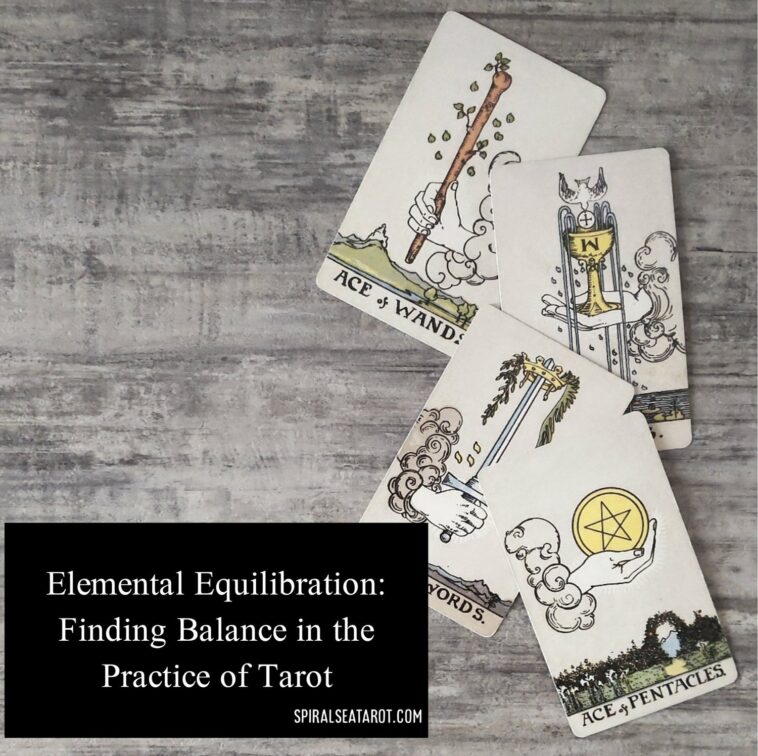
During a recent mentoring session, we found ourselves on the topic of elements. This obviously isn’t an uncommon place to travel when discussing the cards, however, after the session ended, the conversation continued. Through that, we began to think of the elements not just as reference points to understanding tarot, but as a framework to becoming more proficient readers.
In other words, what can the elements teach us about becoming effective with this tool? How can we use these basic concepts to enhance our practice and ensure we’re approaching things in a balanced and whole way?
Before we get into all that, I will preface with this: There is no saying that your aim with tarot should be to become a proficient reader. Outcomes and expectations of this tool vary. In fact, not everyone who uses tarot wishes to explore it from every available angle. Some people enjoy the cards casually. Some use them as a vehicle for study. Not everyone gets a deck of cards with the endgame of being the best reader in town, and that is okay. However, if you do wish to become an adept and well-rounded reader, then I think the following concepts may resonate.
In this post, we will explore each of the 4 elements in order of The Four Kabbalistic Worlds, starting with Fire and moving down to Earth. This seems to make the most sense in terms of how proficiency tends to flow. It starts with a spark, and through action, eventually grounds itself practically, into stable and usable form. As you’re reading through the elements, it may occur to you that one is more active than others in your own practice. Or maybe there is an element you’ve been neglecting. How can more elemental balance be gained? Below are some suggestions for understanding, activating and blending those 4 suits in order to enhance our work with tarot.
Wands represent the Fire element. Fire symbolizes that initial spark, an inner drive, momentum, energy, vitality, passion, sexuality, excitement and creativity.
In terms of learning tarot (or anything for that matter), it often starts with a feeling or desire. It might sound like internal dialogue along the lines of: “This is something that interests me, but I don’t know why”, “I’m excited by the prospect of exploring this”, “When I look at the cards, I feel inspired” or “Something about this pursuit fuels me”.
When we get into anything, we’re often driven by a general interest or curiosity. This drive carries us in those initial stages. If we’re really into something new, we may even find ourselves getting lost in it. When this happens, it doesn’t feel like we’re exerting effort at all and in fact, in some ways, it may feel energizing in itself! This is the limitless energy that is available to us at all times, but which we often experience only as a fleeting gesture.
When we are tapped into it though, it is Fire in motion. It is the drive or passion to pursue this field of tarot (or whatever else interests us). It’s the thing pushing in the background, and the energy behind it. When we cultivate enough Fire in our practice with tarot, we are compelled and carried; it doesn’t feel like work, it feels like play.
Need more Fire in your practice? Remind yourself why you were drawn to tarot to begin with. What gets you excited about working with the cards? Pull out your favourite deck or favorite card to get inspired. If you’ve been too in the books, find a way to make tarot fun again.
Cups represent the Water element. Water symbolizes feelings, emotions, sub consciousness, relationships and intuition.
The drive that Fire produces may be ever present, or more realistically, it may wax and wane. It’s not uncommon for interest to fizzle at some point and for many, this becomes a crossroads. We may even find ourselves asking: Is this really for me? Can I keep going even if I’m losing that momentum?
Water brings in a new element which introduces relationships to the mix. But, we’re not talking about those relationships we have with the people in our lives. We’re talking about our relationship with ourselves and with the cards. If we make it far enough, we inevitably begin to form a personal connection to the cards that exists even if the Fire has simmered. Through this process, we draw parallels to our lives and ourselves thus linking us on a deeper level to the imagery and magick of tarot.
Water also helps us tap into the intuitive approach to reading. It’s the element that assures us that we can read the cards, no matter what we’ve technically learned or what books we’ve read. It taps into the subconscious, draws on archetypes and unlocks facets of ourselves long forgotten. Water allows us to approach tarot in a mystical and fluid manner. It encourages our psychic development, whether that be intuitive or instinctual. When we cultivate enough Water in our practice with tarot, we begin to see and trust the cards, and ourselves, more thoroughly.
Need more Water in your practice? Forget about what you know about the cards and practice just reading intuitively – what do you see? How does the card make you feel? You can also draw a card at random from the deck and let it inspire a poem, song or short story. Meditation is another way to tap into the Water element. Whether you’re meditating with a card or just in general – stepping into that vast space within will help you step out of regular, linear life.
Swords represent the Air element. Air symbolizes intellect, communication, mental processes, ideas and innovation.
With tarot, it’s not just feelings and images that make a for a full reading. If we are to get the most of the cards, we should also become familiar, to a degree, with its history, systems and “rules”. When we engage with the Air element, we are tapping into the intellectual pursuit of this tool. This is book learning, logic leaning and making space for what is already known and what has already been written.
This doesn’t mean you have to agree with or actively use anything you’ve learned. But, having a firm understanding of the tool, what it is and where it came from, will empower you to make appropriate choices in terms of how you wish to work with it. When we cultivate enough Air in our practice with tarot, we become confident in our knowledge of the cards and are able to clearly articulate our understanding of them.
Need more Air in your practice? Read or reread a book about tarot or a topic on the periphery (symbolism, psychology, alchemy, astrology etc.). Find someone knowledgeable and who you resonate with on YouTube and watch some videos on a topic that interests you in this field. Find a mentor or follow accounts on social media who you think you can learn from. Explore the history and origin of tarot/other mystical systems. Start a notebook and consistently journal your card pulls, noting connections and contrasts.
Pentacles represent the Earth element. Earth symbolizes resources, finances, form, practicalities, grounding and the physical.
If you take intuition, combine it with traditional learning, and mix in a dash passion, you have all the ingredients to turn your skills into something practical. This is the element that takes our efforts and grounds them into form. When we cultivate enough Earth in our practice with tarot, we are actively using all we have acquired (intuitively and logically) in a way that is useful, helpful and wise; for both ourselves and others.
Need more Earth in your practice? Give a reading to yourself or someone else. Take a moment to contemplate your practice and define what kind of reader you are. Share your knowledge or skills with others. Consider what kind of impact your practice is having on your life i.e. is it increasing your creativity? Is it helping you think more clearly? Is it enhancing your relationships? Is it making you a better version of yourself?
As you can probably gather by now, it is so important to balance all of these elements in order to have a well rounded and competent practice. If you’re all Water and no Air, that could mean fully intuitive readings with no actual knowledge to back them up. If you’re all Air and no Water, this could look like having your head in the books; not allowing flexibility or intuition to factor in. If you’re lacking in Earth, that could mean all the skill and knowledge that has been cultivated is just theory – it isn’t doing much out in the world. And if you’re lacking Fire? Well, how difficult would it be to sustain anything that wasn’t interesting or exciting?
If you want to take this framework a step further, we’ve come up with a spread to help. It takes the four elements, arranged in order of The Four Worlds, and asks “What do I need to know about my tarot practice where each element is concerned?” Using the entire deck, you will draw 1 card for each spot, starting with Fire and making your way down to Earth (image below).
Depending on the card you draw, you may be able to interpret whether that element is overactive, underactive or balanced, and also what you can do about it. Here is an example reading:
If I drew the 8 of Pentacles in the Fire spot, I would probably see this as a message that ongoing and persistent effort will ensure energy levels stay stable. If I drew the Queen of Swords in the Water spot, I may see this as needing to relax a bit in my practice; maybe I’m being too narrow or logical. If I drew The Sun in the Air spot, I may see this as a sign that I am quite fulfilled where book learning is concerned, and I should continue to find resources that uplift and bring joy. If I drew the Page of Pentacles in the Earth spot, I may see this as the early stages of putting my skills out into the world, and while I may still be a beginner, I’m quite ready to embark.


